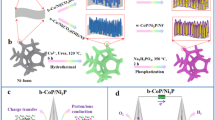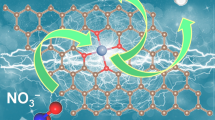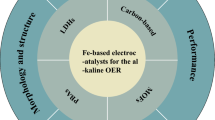Abstract
Electrocatalytic nitrogen reduction reaction (NRR) under ambient conditions has been considered as a promising approach for green ammonia synthesis; however, non-precious metal-based catalysts with excellent NRR electrocatalytic performance have been scarce. Herein, self-supported bimetallic electrocatalysts of Ni12P5/FeP4 nanoplates grown on carbon cloth were synthesized by a combined process of hydrothermal technology and low-temperature phosphidation. The catalyst exhibits excellent electrocatalytic N2 fixation performance with a high NH3 yield rate of 3.08 × 10−10 mol s−1 cm−2 (16.40 μg h−1 mg−1cat ), Faradaic efficiency (39.9%) as well good durability at − 0.1 V in 0.1 M Na2SO4 at ambient conditions, which are attributed to the distinctive nanostructure and rational composition. Our study paves the way for expanding the scope of NRR research and designing more efficient electrochemical ammonia synthesis in the future.







Similar content being viewed by others
References
Seh ZW, Kibsgaard J, Dickens CF, Chorkendorff I, Norskov JK, Jaramillo TF (2017) Combining theory and experiment in electrocatalysis: insights into materials design. Science 355:eaad4998. https://doi.org/10.1126/science.aad4998
Hu Q, Jiang X, He M, Zheng Q, Lam KH, Lin D (2020) Core-shell nanostructured MnO2@Co9S8 arrays for high-performance supercapacitors. Electrochim Acta 338:135896. https://doi.org/10.1016/j.electacta.2020.135896
He X, Bi L, Li Y, Xu C, Lin D (2020) CoS2 embedded graphitic structured N-doped carbon spheres interlinked by rGO as anode materials for high-performance sodium-ion batteries. Electrochim Acta 332:135453. https://doi.org/10.1016/j.electacta.2019.135453
Deng J, Iñiguez JA, Liu C (2018) Electrocatalytic nitrogen reduction at low temperature. Joule 2:846–856. https://doi.org/10.1016/j.joule.2018.04.014
Yandulov DV, Schrock RR (2003) Catalytic reduction of dinitrogen to ammonia at a single molybdenum center. Science 301:76–78. https://doi.org/10.1126/science.1085326
Galloway JN, Townsend AR, Erisman JW, Bekunda M, Cai Z, Freney JR, Martinelli LA, Seitzinger SP, Sutton MA (2008) Transformation of the nitrogen cycle: recent trends, questions, and potential solutions. Science 320:889–892. https://doi.org/10.1126/science.1136674
Lv C, Yan C, Chen G, Ding Y, Sun J, Zhou Y, Yu G (2018) An amorphous noble-metal-free electrocatalyst that enables nitrogen fixation under ambient conditions. Angew Chem Int Ed 57:6073–6076. https://doi.org/10.1002/anie.201801538
Oshikiri T, Ueno K, Misawa H (2016) Selective dinitrogen conversion to ammonia using water and visible light through plasmon-induced charge separation. Angew Chem Int Ed 55:3942–3946. https://doi.org/10.1002/anie.201511189
Ertl G (2008) Reactions at surfaces: from atoms to complexity (nobel lecture). Angew Chem Int Ed 47:3524–3535. https://doi.org/10.1002/anie.200800480
Fang Y, Liu Z, Han J, Jin Z, Han Y, Wang F, Niu Y, Wu Y, Xu Y (2019) High-performance electrocatalytic conversion of N2 to NH3 using oxygen-vacancy-rich TiO2 in situ grown on Ti3C2Tx MXene. Adv Energy Mater 9:1803406. https://doi.org/10.1002/aenm.201803406
Luo Y, Chen G-F, Ding L, Chen X, Ding L-X, Wang H (2019) Efficient electrocatalytic N2 fixation with mxene under ambient conditions. Joule 3:279–289. https://doi.org/10.1016/j.joule.2018.09.011
Rosca V, Duca M, de Groot MT, Koper MTM (2009) Nitrogen cycle electrocatalysis. Chem Rev 109:2209–2244. https://doi.org/10.1021/cr8003696
Hirakawa H, Hashimoto M, Shiraishi Y, Hirai T (2017) Selective nitrate-to-ammonia transformation on surface defects of titanium dioxide photocatalysts. ACS Catal 7:3713–3720. https://doi.org/10.1021/acscatal.7b00611
Ma X-L, Liu J-C, Xiao H, Li J (2018) Surface single-cluster catalyst for N2-to-NH3 thermal conversion. J Am Chem Soc 140:46–49. https://doi.org/10.1021/jacs.7b10354
Cukier RI, Nocera DG (1998) Proton-coupled electron transfer. Annu Rev Phys Chem 49:337–369. https://doi.org/10.1146/annurev.physchem.49.1.337
Costentin C, Robert M, Savéant J-M (2010) Concerted proton − electron transfers: electrochemical and related approaches. Acc Chem Res 43:1019–1029. https://doi.org/10.1021/ar9002812
Tabassum H, Guo W, Meng W, Mahmood A, Zhao R, Wang Q, Zou R (2017) Metal-organic frameworks derived cobalt phosphide architecture encapsulated into B/N Co-doped graphene nanotubes for all pH value electrochemical hydrogen evolution. Adv Energy Mater 7:1601671. https://doi.org/10.1002/aenm.201601671
Wang S, Ichihara F, Pang H, Chen H, Ye J (2018) Nitrogen fixation reaction derived from nanostructured catalytic materials. Adv Func Mater 28:1803309. https://doi.org/10.1002/adfm.201803309
Chu K, Li Q-Q, Liu Y-P, Wang J, Cheng Y-H (2020) Filling the nitrogen vacancies with sulphur dopants in graphitic C3N4 for efficient and robust electrocatalytic nitrogen reduction. Appl Catal B 267:118693. https://doi.org/10.1016/j.apcatb.2020.118693
Zhang X, Wu T, Wang H, Zhao R, Chen H, Wang T, Wei P, Luo Y, Zhang Y, Sun X (2019) Boron nanosheet: an elemental two-dimensional (2D) material for ambient electrocatalytic N2-to-NH3 fixation in neutral media. ACS Catal 9:4609–4615. https://doi.org/10.1021/acscatal.8b05134
Nazemi M, Panikkanvalappil SR, El-Sayed MA (2018) Enhancing the rate of electrochemical nitrogen reduction reaction for ammonia synthesis under ambient conditions using hollow gold nanocages. Nano Energy 49:316–323. https://doi.org/10.1016/j.nanoen.2018.04.039
Chu K, Liu YP, Li YB, Wang J, Zhang H (2019) Electronically coupled SnO2 quantum dots and graphene for efficient nitrogen reduction reaction. ACS Appl Mater Interfaces 11:31806–31815. https://doi.org/10.1021/acsami.9b08055
Chu K, Liu Y-P, Li Y-B, Guo Y-L, Tian Y, Zhang H (2020) Multi-functional Mo-doping in MnO2 nanoflowers toward efficient and robust electrocatalytic nitrogen fixation. Appl Catal B 264:118525. https://doi.org/10.1016/j.apcatb.2019.118525
Bharath G, Madhu R, Chen S-M, Veeramani V, Mangalaraj D, Ponpandian N (2015) Solvent-free mechanochemical synthesis of graphene oxide and Fe3O4–reduced graphene oxide nanocomposites for sensitive detection of nitrite. J Mater Chem A 3:15529–15539. https://doi.org/10.1039/C5TA03179F
Xia J, Yang S-Z, Wang B, Wu P, Popovs I, Li H, Irle S, Dai S, Zhu H (2020) Boosting electrosynthesis of ammonia on surface-engineered MXene Ti3C2. Nano Energy 72:104681. https://doi.org/10.1016/j.nanoen.2020.104681
Ren X, Cui G, Chen L, Xie F, Wei Q, Tian Z, Sun X (2018) Electrochemical N2 fixation to NH3 under ambient conditions: Mo2N nanorod as a highly efficient and selective catalyst. Chem Commun 54:8474–8477. https://doi.org/10.1039/C8CC03627F
Zhang L, Ji X, Ren X, Ma Y, Shi X, Tian Z, Asiri AM, Chen L, Tang B, Sun X (2018) Electrochemical ammonia synthesis via nitrogen reduction reaction on a MoS2 catalyst: theoretical and experimental studies. Adv Mater 30:e1800191. https://doi.org/10.1002/adma.201800191
Guo Y, Yao Z, Timmer BJJ, Sheng X, Fan L, Li Y, Zhang F, Sun L (2019) Boosting nitrogen reduction reaction by bio-inspired FeMoS containing hybrid electrocatalyst over a wide pH range. Nano Energy 62:282–288. https://doi.org/10.1016/j.nanoen.2019.05.051
Zhang C, Shi Y, Yu Y, Du Y, Zhang B (2018) Engineering sulfur defects, atomic thickness, and porous structures into cobalt sulfide nanosheets for efficient electrocatalytic alkaline hydrogen evolution. ACS Catal 8:8077–8083. https://doi.org/10.1021/acscatal.8b02056
Chu K, Cheng Y-H, Li Q-Q, Liu Y-P, Tian Y (2020) Fe-doping induced morphological changes, oxygen vacancies and Ce3+–Ce3+ pairs in CeO2 for promoting electrocatalytic nitrogen fixation. J Mater Chem A 8:5865–5873. https://doi.org/10.1039/c9ta14260f
Han Z, Choi C, Hong S, Wu T-S, Soo Y-L, Jung Y, Qiu J, Sun Z (2019) Activated TiO2 with tuned vacancy for efficient electrochemical nitrogen reduction. Appl Catal B 257:117896. https://doi.org/10.1016/j.apcatb.2019.117896
Song P, Kang L, Wang H, Guo R, Wang R (2019) Nitrogen (N), phosphorus (P)-Codoped porous carbon as a metal-free electrocatalyst for N2 reduction under ambient conditions. ACS Appl Mater Interfaces 11:12408–12414. https://doi.org/10.1021/acsami.8b20472
Chu K, Liu Y-P, Li Y-B, Guo Y-L, Tian Y (2020) Two-dimensional (2D)/2D interface engineering of a MoS2/C3N4 heterostructure for promoted electrocatalytic nitrogen fixation. ACS Appl Mater Interfaces 12:7081–7090. https://doi.org/10.1021/acsami.9b18263
Yan K-L, Qin J-F, Liu Z-Z, Dong B, Chi J-Q, Gao W-K, Lin J-H, Chai Y-M, Liu C-G (2018) Organic-inorganic hybrids-directed ternary NiFeMoS anemone-like nanorods with scaly surface supported on nickel foam for efficient overall water splitting. Chem Eng J 334:922–931. https://doi.org/10.1016/j.cej.2017.10.074
Kang Z, Guo H, Wu J, Sun X, Zhang Z, Liao Q, Zhang S, Si H, Wu P, Wang L, Zhang Y (2019) Engineering an earth-abundant element-based bifunctional electrocatalyst for highly efficient and durable overall water splitting. Adv Func Mater 29:1807031. https://doi.org/10.1002/adfm.201807031
Suryawanshi MP, Ghorpade UV, Shin SW, Suryawanshi UP, Jo E, Kim JH (2019) Hierarchically coupled Ni:FeOOH nanosheets on 3D N-doped graphite foam as self-supported electrocatalysts for efficient and durable water oxidation. ACS Catal 9:5025–5034. https://doi.org/10.1021/acscatal.9b00492
Guo W, Liang Z, Zhao J, Zhu B, Cai K, Zou R, Xu Q (2018) Hierarchical cobalt phosphide hollow nanocages toward electrocatalytic ammonia synthesis under ambient pressure and room temperature. Small Methods 2:1800204. https://doi.org/10.1002/smtd.201800204
Ye Z, Li T, Ma G, Dong Y, Zhou X (2017) Metal-ion (Fe, V Co, and Ni)-doped MnO2 ultrathin nanosheets supported on carbon fiber paper for the oxygen evolution reaction. Adv Func Mater 27:1704083. https://doi.org/10.1002/adfm.201704083
Wang J, Ma X, Qu F, Asiri AM, Sun X (2017) Fe-doped Ni2P nanosheet array for high-efficiency electrochemical water oxidation. Inorg Chem 56:1041–1044. https://doi.org/10.1021/acs.inorgchem.6b02808
Zhang B, Xiao C, Xie S, Liang J, Chen X, Tang Y (2016) Iron-nickel nitride nanostructures in situ grown on surface-redox-etching nickel foam: efficient and ultrasustainable electrocatalysts for overall water splitting. Chem Mater 28:6934–6941. https://doi.org/10.1021/acs.chemmater.6b02610
Li P, Duan X, Kuang Y, Li Y, Zhang G, Liu W, Sun X (2018) Tuning electronic structure of NiFe layered double hydroxides with vanadium doping toward high efficient electrocatalytic water oxidation. Adv Energy Mater 8:1703341. https://doi.org/10.1002/aenm.201703341
Blanchard PER, Grosvenor AP, Cavell RG, Mar A (2008) X-ray photoelectron and absorption spectroscopy of metal-rich phosphides M2P and M3P (M=Cr–Ni). Chem Mater 20:7081–7088. https://doi.org/10.1021/cm802123a
Zhao Y, Jin B, Vasileff A, Jiao Y, Qiao S-Z (2019) Interfacial nickel nitride/sulfide as a bifunctional electrode for highly efficient overall water/seawater electrolysis. J Mater Chem A 7:8117–8121. https://doi.org/10.1039/C9TA01903K
Zhang Y, Shao Q, Long S, Huang X (2018) Cobalt-molybdenum nanosheet arrays as highly efficient and stable earth-abundant electrocatalysts for overall water splitting. Nano Energy 45:448–455. https://doi.org/10.1016/j.nanoen.2018.01.022
Han L, Dong S, Wang E (2016) Transition-metal (Co, Ni, and Fe)-based electrocatalysts for the water oxidation reaction. Adv Mater 28:9266–9291. https://doi.org/10.1002/adma.201602270
Li F-L, Shao Q, Huang X, Lang J-P (2018) Nanoscale trimetallic metal-organic frameworks enable efficient oxygen evolution electrocatalysis. Angew Chem Int Ed 57:1888–1892. https://doi.org/10.1002/anie.201711376
Li Y, Zhang H, Jiang M, Kuang Y, Sun X, Duan X (2016) Ternary NiCoP nanosheet arrays: an excellent bifunctional catalyst for alkaline overall water splitting. Nano Res 9:2251–2259. https://doi.org/10.1007/s12274-016-1112-z
Jiang X, Li Y, He M, Zhou L, Zheng Q, Xie F, Jie W, Lin D (2019) Construction of NiFeP/CoP nanosheets/nanowires hierarchical array as advanced electrocatalysts for water oxidation. Int J Hydrogen Energy 44:19986–19994. https://doi.org/10.1016/j.ijhydene.2019.06.018
Acknowledgements
This work was supported by Sichuan Science and Technology Program (2018JY0447).
Author information
Authors and Affiliations
Corresponding author
Ethics declarations
Conflict of interest
There are no conflicts of interest to declare.
Additional information
Publisher's Note
Springer Nature remains neutral with regard to jurisdictional claims in published maps and institutional affiliations.
Electronic supplementary material
Below is the link to the electronic supplementary material.
Rights and permissions
About this article
Cite this article
Jiang, X., He, M., Tang, M. et al. Nanostructured bimetallic Ni–Fe phosphide nanoplates as an electrocatalyst for efficient N2 fixation under ambient conditions. J Mater Sci 55, 15252–15262 (2020). https://doi.org/10.1007/s10853-020-05085-5
Received:
Accepted:
Published:
Issue Date:
DOI: https://doi.org/10.1007/s10853-020-05085-5




